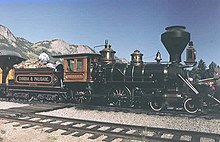Conservation and restoration of rail vehicles
This article needs additional citations for verification. (March 2009) |
Restored trains are historic trains that have been removed from service and later restored to their past condition, as opposed to having never been removed from service, like UP 844, the only U.S. steam locomotive to never be retired. They are operated in present-day service as moving examples of living history, as opposed to static exhibits. The majority of restored trains are operated at heritage railways and railway museums, although they can also be found on the main lines or branch lines of the commercial working railway, operated by specialist railtour companies or museum groups.
For authenticity, the location/route of preserved trains is often chosen to match the original trains used.
In the United States

The restoration of historic railway equipment has gained importance in the United States, primarily because of a large amount of steam locomotives and cabooses donated by railroads to cities and museums, many of which have been displayed in parks for many years. Often these restoration projects are accomplished by a local railroad club or chapters of a national organization.
Examples of major projects accomplished by clubs are D&RGW 315, which was displayed in the city park in Durango, Colorado, until removed by the Durango Railway Historical Society and restored to operation,[1] as well as D&RGW 223, which was displayed at Liberty Park in Salt Lake City, Utah until moved to Ogden and restored by the Golden Spike Chapter of the Railway & Locomotive Historical Society.[2]
Eureka & Palisades 4, also known as the Eureka, was purchased by a lawyer from Reno, Nevada. She was restored and is still privately owned, operating occasionally on the Durango & Silverton and Cumbres & Toltec Scenic Railroads in Colorado.
See also
References
- ^ "D&RGW 315". Durango Railway Historical Society. Retrieved 25 January 2011.
- ^ "D&RGW 223". GoldenSpikeR&LHS. Retrieved 25 January 2011.
